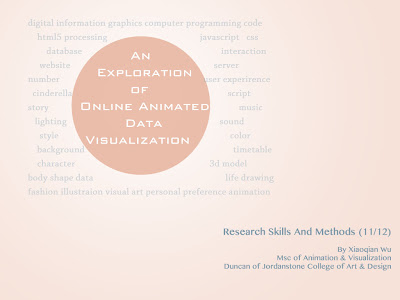Storyboard:
 |
| Storyboard Version 1.0 |
Script:
Characters: Cinderella, Two Stepsisters, Fairy Godmother, Prince Smarmy
Part I: A Small Animation About Cinderella
Cinderella watched her two stepsisters leaving the house, disappeared in the door.
Cinderella: Oh, I really wished to go to the party. All I want is one night, a wonderful evening which is different and happy.
She looked at her grey dress sadly.
Suddenly, the Fairy Godmother appeared with a sparkle.
Fairy: Poor girl, come on, I can help you go to the ball.
Cinderella: But I don’t have an evening dress.
Fairy: I can make one for you. What kind you dress do you want?
Cinderella (said in hesitate): I don’t know. Maybe something like the one my sister dressed tonight?
Fairy: I am worry that style might not fit in you.
Cinderella: I’m sorry but I really have no idea. I have never go to a ball before.
Fairy (took out a magic mirror): Don’t worry. Just tell me some data about your self? This magic mirror will tell you what you should wear and make you beautiful.
Part II: Data Interaction
Cinderella: Magic Mirror on the wall, what should I wear tonight?
Mirror: I can help you if you tell me your body shape?
(Show several body shapes on the mirror that you can choose)
Cinderella choose the “unknown” option.
Mirror: Well, don’t worry. Just tell me some data of yourself?
Using a fairy stick with sparkle to draw a line on Cinderella’s shoulder, bust, waist, and rise. After each measurement, you can enter the data.
Show the result of the body shape.
Mirror: Good job, now could you tell me the color of your skin and hair?
(Show a color board to choose from.)
Mirror: Hmm, and tell me where you are going to meet you princess tonight?
(Show some occasion.)
Mirror: Great, here’s some advice for you, want to try them on?
(Show several clothes)
Cinderella picked one(in fact, the user did this)
Cinderella got dress and turn around.
(3 Options: 1.Fantasy, exactly what I want; 2. Well, I’m not sure; 3.Oh, I hate it!)
1. Cinderella went with the pumpkin car happily. Then asked the user “do you want to know what most pretty women choose nowadays? If yes, show the data visualization part.
2. Cinderella can watch the data visualization part, or do a test about personal interest, or do a test about the person she is going to me tonight, then get more advice and choose another dress.
3. Cinderella kicked the mirror and choose another dress or do more test.
Mirror: Would you like to tell me your name and a key password so that I can remember you?
Part II: Data Visualization.
Do some visualization effect from the data of the website user and other data about fashion interest.
Context:
Women’s favorite color over the past 10 years;
Dresses over the past 100 years;
Hair styles over the past 100 years;
Classify Data: traditional chart, the tree structure-data, the mesh and relational data, the mutative process data, the sub-category data, the timeline data, the heat map-data, the thematic data, the mutative process data.
Advice:
From Peer Review:
For the dress part, there are still too many models to draw, so maybe I should reduce the animation in this part;
The drawing style seemed much too like a wedding style, I should stand on the water color style I imagined in the beginning.
The animals in the storyboard seemed to be a good idea for interaction. Maybe I should do more in the part.
I should make more connection with the social networks or companies like facebook or ebay.
What's lucky for me is that I could get a lot of help from my classmates.
From my Supervisor Mr. O'Neill:
Cindy has moved forwards with a first attempt at a storyboard for her interface designs. This has been very helpful in supporting discussions about how to develop her ideas.
Cindy should continue to develop the story board more fully working through various iterations of her design ideas. This process should help in planning out how things will work in her final project.
The final project will be completed using processing.js and be delivered as a web based interface.
From Sharon:
The house should be bigger base on the story. For the dressing part, I could learn something from the children's dressing-up book.
For style suggestion, I could ask for some advice from Dan and Ms. Stevenson, who are good at fashion.















